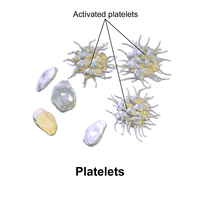
Photo from wikipedia
Abstract High-on treatment platelet reactivity (HTPR) leads to more prevalence of thrombotic event in patients undergoing percutaneous coronary interventions (PCI). Dual antiplatelet therapy with aspirin in addition to one P2Y12… Click to show full abstract
Abstract High-on treatment platelet reactivity (HTPR) leads to more prevalence of thrombotic event in patients undergoing percutaneous coronary interventions (PCI). Dual antiplatelet therapy with aspirin in addition to one P2Y12 inhibitor is commonly administrated to reduce HTPR. However, ‘one size fits all’ antiplatelet strategy is widely implemented due to lacking benefits with tailored strategy. One reason for the failure of tailored treatment might be less specificity of the current indicators for HTPR. Therefore, searching for specific indicators for HTPR is critical. Thromboelastograph with platelet mapping (TEGpm) assay has been explored for identifying HTRP. Variables of TEGpm assay, including maximum amplitude (MA) induced by thrombin (MAthrombin), R time, platelet aggregation rate induced by ADP (TEGaradp) and MA induced by ADP (MAadp) have been demonstrated to be able to identify HTPR in post-PCI patients. However, these variables for HTPR might be less specific. Thus, in the present study, a novel variable nMAadp was derived by removing fibrin contribution from MAadp and analyzed for its usefulness in determining HTPR. In addition, MAthrombin, R time, MAadp and TEGaradp were also examined for determining HTPR. In conclusion, nMAadp and TEGaradp were demonstrated to be independent indicators for HTPR; nMAadp had the strongest power to identify HTPR with cutoff value of 26.3 mm; MAthrombin and R time were not significantly different between patients with and without HTPR; combination of TEGaradp and nMAadp further improved the ability to identify HTPR with an AUC of 0.893.
Journal Title: Bioscience Reports
Year Published: 2020
Link to full text (if available)
Share on Social Media: Sign Up to like & get
recommendations!